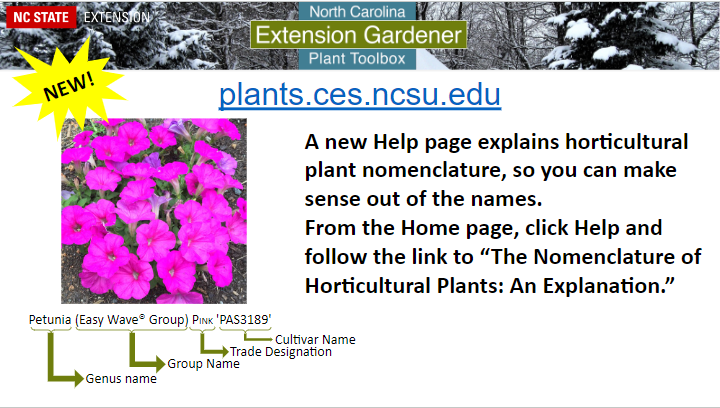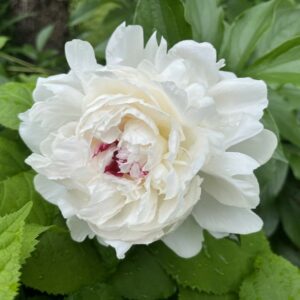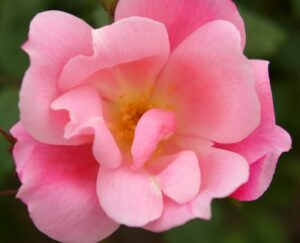The Nomenclature of Horticultural Plants: An Explanation
go.ncsu.edu/readext?964561
en Español / em Português
El inglés es el idioma de control de esta página. En la medida en que haya algún conflicto entre la traducción al inglés y la traducción, el inglés prevalece.
Al hacer clic en el enlace de traducción se activa un servicio de traducción gratuito para convertir la página al español. Al igual que con cualquier traducción por Internet, la conversión no es sensible al contexto y puede que no traduzca el texto en su significado original. NC State Extension no garantiza la exactitud del texto traducido. Por favor, tenga en cuenta que algunas aplicaciones y/o servicios pueden no funcionar como se espera cuando se traducen.
Português
Inglês é o idioma de controle desta página. Na medida que haja algum conflito entre o texto original em Inglês e a tradução, o Inglês prevalece.
Ao clicar no link de tradução, um serviço gratuito de tradução será ativado para converter a página para o Português. Como em qualquer tradução pela internet, a conversão não é sensivel ao contexto e pode não ocorrer a tradução para o significado orginal. O serviço de Extensão da Carolina do Norte (NC State Extension) não garante a exatidão do texto traduzido. Por favor, observe que algumas funções ou serviços podem não funcionar como esperado após a tradução.
English
English is the controlling language of this page. To the extent there is any conflict between the English text and the translation, English controls.
Clicking on the translation link activates a free translation service to convert the page to Spanish. As with any Internet translation, the conversion is not context-sensitive and may not translate the text to its original meaning. NC State Extension does not guarantee the accuracy of the translated text. Please note that some applications and/or services may not function as expected when translated.
Collapse ▲ The scientific names of wild plants are governed by the rules of nomenclature codified in the International Code of Nomenclature for algae, fungi, and plants. The latest version of the Code is the Shenzen Code, which was agreed upon during a conference in Shenzen, China in July 2017 and published in 2018. The Code sets out the rules for naming wild plants. Plants in horticulture are often wild-type species, so their names are governed by the Shenzen Code. Hybrids and cultivars, however, are governed by a different code, the International Code of Nomenclature for Cultivated Plants.
The scientific names of wild plants are governed by the rules of nomenclature codified in the International Code of Nomenclature for algae, fungi, and plants. The latest version of the Code is the Shenzen Code, which was agreed upon during a conference in Shenzen, China in July 2017 and published in 2018. The Code sets out the rules for naming wild plants. Plants in horticulture are often wild-type species, so their names are governed by the Shenzen Code. Hybrids and cultivars, however, are governed by a different code, the International Code of Nomenclature for Cultivated Plants.
The Cultivar

Peony ‘Festiva Maxima’ (Scott Zona CC BY-NC 2.0)
The basic category of cultivated plants is the cultivar (a portmanteau of “cultivated variety”). The origin of the cultivar, whether selected from the wild or created through human intervention (e.g., hybridization) is irrelevant to its recognition as a cultivar.
- Cultivar is not equivalent to the botanical ranks of variety, subspecies, or form, but cultivars can be selected from plants at any of these infraspecific ranks. Colloquially, we sometimes refer to cultivars as “varieties” or “strains,” but this ambiguous language should be avoided.
- A cultivar is an assemblage of plants 1) that has been selected for a particular characteristic or combination of characteristics, 2) is stable and uniform for those characteristics, and 3) when propagated appropriately retains those characteristics.
- Cultivar names are, by convention, put in single quotes, not Italicized, and may be written in any of several ways. Example: Cornus ‘Ozark Spring’ or Cornus florida ‘Ozark Spring’ or ‘Ozark Spring’ flowering dogwood are equivalent ways of writing the cultivar’s name.
- Prior to 1996, the abbreviation “cv.” preceding a cultivar epithet was permitted as an alternative to the use of single quotes. However, in modern works, the format should be corrected to single quotes.
- Each word of a cultivar epithet must start with an initial capital letter unless linguistic custom demands otherwise. Exceptions are words after a hyphen (unless they are proper nouns), conjunctions, and prepositions other than those in the first word of the epithet. Examples: Salvia coccinea ‘Lady in Red’ or Paeonia ‘Duchesse d’Orléans’.
- Cultivar epithets created after 1 January 1959 may contain words in any language but may not be entirely in Latin. Cultivars named before 1959 may be in Latin, and these names are “grandfathered in.” Example: Paeonia ‘Festiva Maxima’ was named in 1851 and is retained.
- For cultivars named after 1 January 1996, the epithet may contain the following punctuation marks: the apostrophe (’), the comma (,), up to two non-adjacent exclamation marks (!), the period (.), the hyphen (-), the forward-slash (/) or back-slash (\) symbols. Other typographical symbols (@, #, $, &) are not allowed. Note that in standard American English grammar, commas and periods go within the quotation marks; however, that rule is suspended herein to prevent the inadvertent inclusion of the punctuation with the cultivar name.
- Single descriptive adjectives like “Pink” or “Tall” are not allowed, but they can be combined with other words. Example: Cocos nucifera ‘Panama Tall’ and Verbena hastata ‘Pink Spires’ are acceptable names.
The Group

Petunia (Easy Wave® Group) Pink ‘PAS3189’ (Scott Zona CC BY-NC 2.0)
The Group is a formally recognized category of cultivars and/or plants with character-based similarities.
- A cultivar that is part of one Group might also belong to another Group if such a double assignment serves a practical purpose. Example: Solanum tuberosum ‘Desiree’ may be designated part of a Maincrop Group and a Red-skinned Group since both such designations may be practical to growers of potatoes. It may thus be written Solanum tuberosum (Maincrop Group) ‘Desiree’ in one classification or as Solanum tuberosum (Red-skinned Group) ‘Desiree’ in another, depending on the purpose of the classification used.
- Plant breeders often use “series” or “family” as the equivalent of Group. Example: Petunia Easy Wave® ‘PAS3189’. The Group name is Easy Wave®. Note that a Group name may be trademarked.
- Best practice: Group names are conventionally written with capitalized initial letters and “Group” is spelled out. Example: Rhododendron Encore Group or Encore Group azalea are equivalent ways of referring to this Group of hybrid azaleas.
- Best practice: When used along with a cultivar name, a Group epithet is placed within parentheses immediately before the cultivar epithet. Example: Fagus sylvatica (Atropurpurea Group) ‘Riversii’.
The Grex

Paphiopedilum Maudiae grex (Emilio Esteban-Infantes CC BY-NC-ND 2.0)
The grex is used only for orchid hybrids. A grex is the name of the offspring of a particular hybrid cross (and its reciprocal).
- A single grex may give rise to any number of cultivars. Example: Paphiopedilum Maudiae is an orchid grex first made in 1900. It is a cross between Paph. callosum and Paph. lawrenceanum. Recently named cultivars of this grex include: Paph. Maudiae ‘Baronja’, Paph. Maudiae ‘Charlotte’, Paph. Maudiae ‘The Queen’, and Paph. Maudiae ‘Amco’.
- Grex status is indicated by the use of the word “grex” or by the standard contraction “gx,” but more often it is omitted entirely. Grex epithets are not italicized. Example: Paph. Maudiae grex ‘Amco’ = Paph. Maudiae ‘Amco’.
The Trade Designation

Rose (Knock Out® Group) Blushing ‘Radyod’ (Kiya CC BY-SA 2.0)
Trade Designations, which may or may not be trademarked, are also called marketing names. These are names used in marketing cultivars, groups, or grexes. The Code does not regulate trade designation, so the rules that apply to cultivars, groups, and grexes do not apply to trade designations. Trade designations must always be distinguished typographically from cultivar, Group, and grex epithets. In the Roman script, small capitals are conventionally used (but are not available on the Portal). Examples:
Rosa (Knock Out® Group) Easy Bee-zy™ ‘SRPylwko’ – In this example, the cultivar is ‘SRPylwko’, but it is marketed with the trademarked name Easy Bee-zy™. The Group is Knock Out®. Note that both the Group name and trade designation are proprietary.

The Trade Designation, Easy Bee-zy™, is written in small caps.
Petunia (Wave® Group) Purple ‘PAS760727’ – In this one, the cultivar is ‘PAS1302763’, but the marketing name is Purple, which belongs to the Wave® Group. The marketing name, Purple, cannot be a cultivar name because color names used alone are not allowed to be used as cultivar names.

The Trade Designation, Purple, is written in small caps.
Rhododendron (Encore Group) Autumn Embers® ‘Conleb’ – This cultivar, one of the Encore Group of azaleas that bloom in spring and autumn, is ‘Conleb’ but marketed under the trade designation Autumn Embers®.

Petunia (Easy Wave® Group) White ‘PAS760712’ (Serres Fortier CC BY 2.0)


